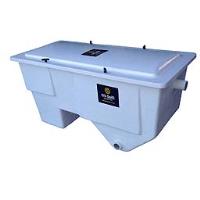 Add My Company
Add My Company
Sign In

OIL WATER SEPARATOR THEORY
Coalescing Oil Water Separators: Coalescing Oil Water Separators are passive, physical separation systems designed for removal of oils, fuels, hydraulic fluids, LNAPL and DNAPL products from water. Oil Spill Products Separators designed performance can be described by a combination of Stokes Law and current coalescing plate theory, wherein, the oil droplet rise rate and other parameters dictate the surface area required for gravity & coalescent separation.
Separation Process: The water/oil mixture enters the separator and is spread out horizontally, distributed through an energy and turbulence diffusing device. The mixture enters the Flopak media where laminar and sinusoidal flow is established and the oils impinge on the media surface. As oils accumulate they coalesce into larger droplets, rising upward through the pack corrugations until they reach the top of the pack, where they detach and rise to the water’s surface. At the same time solids encounter the media and slide down the corrugations, falling into the v-hopper under the Flopak media.
Stokes Law: This equation relates the terminal settling or rise velocity of a smooth, rigid sphere in a viscous fluid of known density and viscosity to the diameter of the sphere when subjected to a known force field (gravity). The equation is:
V = (2gr²)(d1-d2)/9µ
where
V = velocity of rise (cm sec-¹),
g = acceleration of gravity (cm sec-²),
r = “equivalent” radius of particle (cm),
dl = density of particle (g cm -³),
d2 = density of medium (g cm-³), and
µ = viscosity of medium (dyne sec cm-²).
Coalescence: Gravity separation utilizes the difference in specific gravity between the oil and water. Oil separates from a fluid at a rate explained by Stokes Law. The formula predicts how fast an oil droplet will rise or settle through water based on the density and size of the oil droplet size and the distance the object must travel. Our separators are built to exploit both variables of Stokes Law.
With the use of our Flopak media oil only need rise a short distance before encountering the oleophilic, coalescing media plates inside the separation chamber as opposed to rising a great distance in gravity separation. Upon impinging on the plates the oils coalesce (gather) into larger droplets until the droplet buoyancy is sufficient to pull away from the media and rise to the water’s surface. The design will meet particular design criteria as indicated below:
The hydraulic distribution of the influent flow must assure full usage of the cross-sectional area of the media to fully utilize the plate pack’s surface area.
Flow control and direction must be determined to prevent hydraulic short circuiting around, under or over the media pack.
A laminar flow condition must be maintained (Reynolds “Re” number less than 500) in order to assist droplets to rise. Per the American Petroleum Institute’s (API) Publication 421 of February 1990.
Horizontal flow through velocities in the separator must not exceed 3 feet per minute or 15 times the rate of rise of the droplets whichever is smaller.
The media containment chamber design, plate design/angle and spacing sufficient to facilitate removal of accumulating solids. Plates are to be smooth surfaced and angled at 60 deg.
Flopak Coalescing Media Design
OSP's Flopak coalescing media provides a laminar flow path that creates a quiescent zone to facilitate the impact with and attachment of oils to the media surface by reducing waste stream turbulence and velocity. This control of the waste stream creates a more ideal environment for oil removal. By virtue of our Flopak media design, solids will also collide with the media and settle to the separator bottom to some degree. Due to oil typically being lighter than water, they (oil) will rise up the coalescing plate. As the oil droplets rise up the plate they will coalesce or come together with other droplets, creating progressively larger droplets. Once the droplet size is sufficient or the droplet reaches the top of the media plate the droplet pulls away from the plate and rises to the water surface. To some degree, the solids replicate this process in reverse (settling).
Gravity Separation vs. Coalescing Plates
Two types of oil water separator exist today in varying types of design, but all are dependent on these two types of design.
The first and oldest type is gravity or conventional separation, simple separation via gravity (density differential between two immiscible liquids leads to one of them rising above the other). This design, when designed properly (or even improperly) provides a certain tank length, width and depth that provides a wide, quiet spot in the pipeline to give oils time to rise. This design (also known as an API separator) generally provides a discharge oil concentration of 100 ppm based on a 150 micron droplet size. The API type design relies on a large water volume. This correlates to a tank size that can be 5 times the size of an equally sized coalescing separator.
The coalescing design is known by many names i.e. parallel plate, corrugated plate, slant rib coalescer so on and so forth. However, the concept, operation and design are generally the same. The coalescing concept is based on having a large surface area in contact with the waste stream (coalescing plates). The more surface area provided, the more enhanced the separation process will typically be. By using the coalescing media, the size of the tank is reduced and a higher performance is attained than by gravity separation. OSP's Flopak coalescing design provides a discharge oil concentration of 10 PPM or less with an oil droplet size of 30 or as small as a 20 micron oil droplet.
For more information on Oil Water Separator Guide talk to Oil Spill Products Limited
Enquire Now
List your company on FindTheNeedle.

